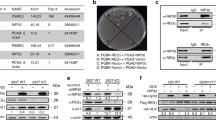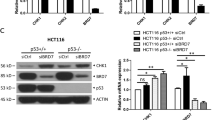Abstract
Mammalian checkpoint kinases 1 and 2 (Chk1 and Chk2) are essential kinases that are involved in cell cycle checkpoint control, and the abrogation of either has been proposed as one way to sensitize cancer cells to DNA-damaging agents. However, it remains unclear which kinase is the most therapeutically relevant target, and whether multiple kinases might need to be targeted to achieve the best efficacy because of their overlapping substrate spectra and redundant functions. To clarify this issue, we established asynchronous cell cycle arrest models to investigate the therapeutic outcomes of silencing Chk1 and Chk2 in the presence of irradiation or cisplatin. Our results showed that Chk1- and Chk2-targeting small interference RNAs (siRNAs) demonstrated synergistic effects when both siRNAs were used simultaneously. Interestingly, Chk1 and Chk2 co-expression occurred in ∼90% of neoplastic tissues examined and showed no difference in neoplastic versus non-neoplastic tissues. Therefore, the selective targeting of Chk1 and Chk2 by oncolytic adenovirus mutants was chosen to treat resistant tumor xenograft mice, and the maximum antitumoral efficacy was achieved with the combined co-abrogation of Chk1 and Chk2 in the presence of low-dose cisplatin. This work deepens our understanding of novel strategies that target checkpoint pathways and contributes to the development of novel, potent and safe checkpoint abrogators.
This is a preview of subscription content, access via your institution
Access options
Subscribe to this journal
Receive 12 print issues and online access
$259.00 per year
only $21.58 per issue
Buy this article
- Purchase on Springer Link
- Instant access to full article PDF
Prices may be subject to local taxes which are calculated during checkout






Similar content being viewed by others
References
Zhou BB, Elledge SJ . The DNA damage response: putting checkpoints in perspective. Nature 2000; 408: 433–439.
Wong CF, Guminski A, Saunders NA, Burgess AJ . Exploiting novel cell cycle targets in the development of anticancer agents. Curr Cancer Drug Targets 2005; 5: 85–102.
Dixon H, Norbury CJ . Therapeutic exploitation of checkpoint defects in cancer cells lacking p53 function. Cell Cycle 2002; 1: 362–368.
Zhou BB, Bartek J . Targeting the checkpoint kinases: chemosensitization versus chemoprotection. Nat Rev Cancer 2004; 4: 216–225.
Abraham RT . Cell cycle checkpoint signaling through the ATM and ATR kinases. Genes Dev 2001; 15: 2177–2196.
Mailand N, Falck J, Lukas C, Syljuasen RG, Welcker M, Bartek J et al. Rapid destruction of human Cdc25A in response to DNA damage. Science 2000; 288: 1425–1429.
Bartek J, Lukas J . Chk1 and Chk2 kinases in checkpoint control and cancer. Cancer Cell 2003; 3: 421–429.
Zhao H, Watkins JL, Piwnica-Worms H . Disruption of the checkpoint kinase 1/cell division cycle 25A pathway abrogates ionizing radiation-induced S and G2 checkpoints. Proc Natl Acad Sci USA 2002; 99: 14795–14800.
Sorensen CS, Syljuasen RG, Falck J, Schroeder T, Ronnstrand L, Khanna KK et al. Chk1 regulates the S phase checkpoint by coupling the physiological turnover and ionizing radiation-induced accelerated proteolysis of Cdc25A. Cancer Cell 2003; 3: 247–258.
Falck J, Mailand N, Syljuasen RG, Bartek J, Lukas J . The ATM-Chk2-Cdc25A checkpoint pathway guards against radioresistant DNA synthesis. Nature 2001; 410: 842–847.
Falck J, Petrini JH, Williams BR, Lukas J, Bartek J . The DNA damage-dependent intra-S phase checkpoint is regulated by parallel pathways. Nat Genet 2002; 30: 290–294.
Shao RG, Cao CX, Shimizu T, O'Connor PM, Kohn KW, Pommier Y . Abrogation of an S-phase checkpoint and potentiation of camptothecin cytotoxicity by 7-hydroxystaurosporine (UCN-01) in human cancer cell lines, possibly influenced by p53 function. Cancer Res 1997; 57: 4029–4035.
Lara PN Jr., Mack PC, Synold T, Frankel P, Longmate J, Gumerlock PH et al. The cyclin-dependent kinase inhibitor UCN-01 plus cisplatin in advanced solid tumors: a California cancer consortium phase I pharmacokinetic and molecular correlative trial. Clin Cancer Res 2005; 11: 4444–4450.
Kohn EA, Yoo CJ, Eastman A . The protein kinase C inhibitor Go6976 is a potent inhibitor of DNA damage-induced S and G2 cell cycle checkpoints. Cancer Res 2003; 63: 31–35.
Jobson AG, Cardellina JH 2nd, Scudiero D, Kondapaka S, Zhang H, Kim H et al. Identification of a Bis-guanylhydrazone [4,4'-Diacetyldiphenylurea-bis(guanylhydrazone); NSC 109555] as a novel chemotype for inhibition of Chk2 kinase. Mol Pharmacol 2007; 72: 876–884.
Collins I, Garrett MD . Targeting the cell division cycle in cancer: CDK and cell cycle checkpoint kinase inhibitors. Curr Opin Pharmacol 2005; 5: 366–373.
Chen Z, Xiao Z, Chen J, Ng SC, Sowin T, Sham H et al. Human Chk1 expression is dispensable for somatic cell death and critical for sustaining G2 DNA damage checkpoint. Mol Cancer Ther 2003; 2: 543–548.
Ou YH, Chung PH, Sun TP, Shieh SY . p53 C-terminal phosphorylation by CHK1 and CHK2 participates in the regulation of DNA-damage-induced C-terminal acetylation. Mol Biol Cell 2005; 16: 1684–1695.
Gao Q, Huang X, Tang D, Cao Y, Chen G, Lu Y et al. Influence of chk1 and plk1 silencing on radiation- or cisplatin-induced cytotoxicity in human malignant cells. Apoptosis 2006; 11: 1789–1800.
Gao Q, Zhou J, Huang X, Chen G, Ye F, Lu Y et al. Selective targeting of checkpoint kinase 1 in tumor cells with a novel potent oncolytic adenovirus. Mol Ther 2006; 13: 928–937.
Zhou J, Gao Q, Chen G, Huang X, Lu Y, Li K et al. Novel oncolytic adenovirus selectively targets tumor-associated polo-like kinase 1 and tumor cell viability. Clin Cancer Res 2005; 11: 8431–8440.
Hirao A, Kong YY, Matsuoka S, Wakeham A, Ruland J, Yoshida H et al. DNA damage-induced activation of p53 by the checkpoint kinase Chk2. Science 2000; 287: 1824–1827.
Hirao A, Cheung A, Duncan G, Girard PM, Elia AJ, Wakeham A et al. Chk2 is a tumor suppressor that regulates apoptosis in both an ataxia telangiectasia mutated (ATM)-dependent and an ATM-independent manner. Mol Cell Biol 2002; 22: 6521–6532.
Jack MT, Woo RA, Hirao A, Cheung A, Mak TW, Lee PW . Chk2 is dispensable for p53-mediated G1 arrest but is required for a latent p53-mediated apoptotic response. Proc Natl Acad Sci USA 2002; 99: 9825–9829.
Castedo M, Perfettini JL, Roumier T, Yakushijin K, Horne D, Medema R et al. The cell cycle checkpoint kinase Chk2 is a negative regulator of mitotic catastrophe. Oncogene 2004; 23: 4353–4361.
Huang M, Miao ZH, Zhu H, Cai YJ, Lu W, Ding J . Chk1 and Chk2 are differentially involved in homologous recombination repair and cell cycle arrest in response to DNA double-strand breaks induced by camptothecins. Mol Cancer Ther 2008; 7: 1440–1449.
Yu Q, Rose JH, Zhang H, Pommier Y . Antisense inhibition of Chk2/hCds1 expression attenuates DNA damage-induced S and G2 checkpoints and enhances apoptotic activity in HEK-293 cells. FEBS Lett 2001; 505: 7–12.
Xiao Z, Chen Z, Gunasekera AH, Sowin TJ, Rosenberg SH, Fesik S et al. Chk1 mediates S and G2 arrests through Cdc25A degradation in response to DNA-damaging agents. J Biol Chem 2003; 278: 21767–21773.
Sorensen CS, Hansen LT, Dziegielewski J, Syljuasen RG, Lundin C, Bartek J et al. The cell-cycle checkpoint kinase Chk1 is required for mammalian homologous recombination repair. Nat Cell Biol 2005; 7: 195–201.
Wang HC, Chou WC, Shieh SY, Shen CY . Ataxia telangiectasia mutated and checkpoint kinase 2 regulate BRCA1 to promote the fidelity of DNA end-joining. Cancer Res 2006; 66: 1391–1400.
Ghosh JC, Dohi T, Raskett CM, Kowalik TF, Altieri DC . Activated checkpoint kinase 2 provides a survival signal for tumor cells. Cancer Res 2006; 66: 11576–11579.
Zaugg K, Su YW, Reilly PT, Moolani Y, Cheung CC, Hakem R et al. Cross-talk between Chk1 and Chk2 in double-mutant thymocytes. Proc Natl Acad Sci USA 2007; 104: 3805–3810.
Ma CX, Cai S, Li S, Ryan CE, Guo Z, Schaiff WT et al. Targeting Chk1 in p53-deficient triple-negative breast cancer is therapeutically beneficial in human-in-mouse tumor models. J Clin Invest 2012; 122: 1541–1552.
Niida H, Murata K, Shimada M, Ogawa K, Ohta K, Suzuki K et al. Cooperative functions of Chk1 and Chk2 reduce tumour susceptibility in in vivo. EMBO J 2010; 29: 3558–3570.
Acknowledgements
This work was supported by grants from the National Natural Science Foundation of China (81072135, 81372801, 30901749 and 81272426); and the ‘973’ Program of China (no. 2009CB521808).
Author information
Authors and Affiliations
Corresponding author
Ethics declarations
Competing interests
The authors declare no conflict of interest.
Rights and permissions
About this article
Cite this article
Ye, F., Yang, Z., Liu, Y. et al. Co-abrogation of Chk1 and Chk2 by potent oncolytic adenovirus potentiates the antitumor efficacy of cisplatin or irradiation. Cancer Gene Ther 21, 209–217 (2014). https://doi.org/10.1038/cgt.2014.20
Received:
Revised:
Accepted:
Published:
Issue Date:
DOI: https://doi.org/10.1038/cgt.2014.20



